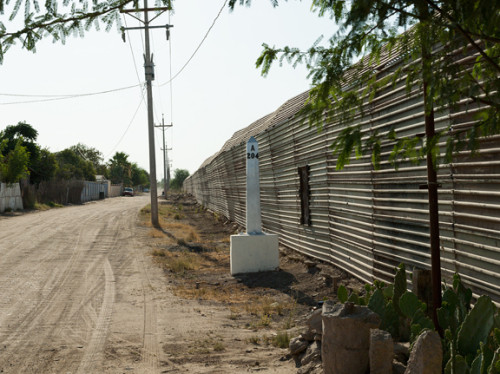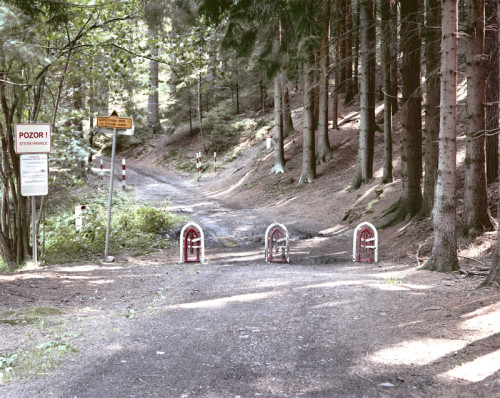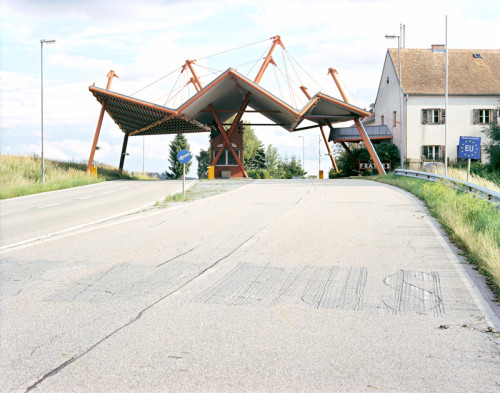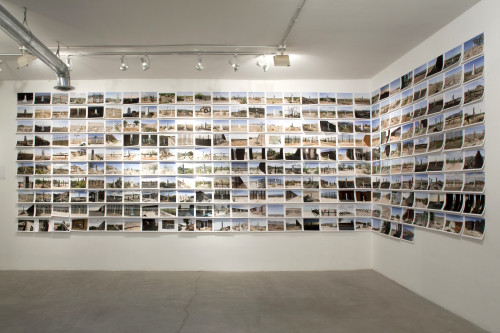David Taylor and Ignacio Evangelista at Colorado Photographic Arts Center
02.27.14- 04.12.14
3/31/14

David Taylor “Border Monument 204A” From “276 Views of the U.S./Mexico Border” image courtesy the artist
The exhibition, David Taylor and Ignacio Evangelista, at Colorado Photographic Art Center pairs together two photographic projects that document borders on two different continents reflecting the current political climate. Evangelista and Taylor’s different choices of inclusion or exclusion of work and each of the artist’s choices of display mark two opposing manifestations of political and authorial privilege. And while Evangelista’s seven large architecturally loaded photographs from once militarized but now deserted European Union border crossings from his series “After Schengen” surround Taylor’s large project “276 Views of the U.S. Mexican Border,” 2007-14 in the gallery space Taylor’s grid is prominent.
Printed small format and made smaller yet with a surrounding white border Taylor’s photographic documents are displayed in a linear, tight grid, from one to 276. In this format “276 Views” now exists as conceptual document that has theoretical complications.
Presented as a grid each photograph documents Taylor’s movements on the U.S. Mexican border. Individually each work is reduced and reproduced in a small-scale format. Each separate work no longer effectively tells a story about the marks and scratches left by immigrants or the lives of the U.S. men and women who work and live in this militarized zone. Exhibited as a monolithic grid that encompasses the corner of the room, “276 Views” is a document of the artist’s movements. Taylor is now the subject of the photographs.
While most are beautifully composed around one of the 276 obelisks that mark and penetrate the border from El Paso/Juarez to Tijuana/San Diego, a few of the images are dry digital satellite images. These images hold the places where the artist was absolutely not able to access.
Interestingly, similar to Evangelista who could freely work both sides of the obsolete European borders, Taylor’s project photographing all of the obelisks is a documentation of his ability to, for the most part, go back and forth across the border from Mexico to the U.S. without, hypothetically speaking, the same consequences of a person of Mexican nationality. The idea that there were in that point in time places that he could not physically travel marks the highly complex history of the U.S. Mexican border seized after the Mexican American War.
The obelisk, documented at each site, holds the contradiction of a nation defined by an abstract and romantic vision of manifest destiny. Immigrant people traveled out onto the frontier and negotiated open spaces only to fence and negate another person’s freedom of movement. In “276 Views” gridded and linear format each photographed space is tightly wound into a representing number on a chart. The photograph’s printed borders hem in the obelisk itself. Even the wide-open spaces are repetitively fenced and plotted. Does the conceptual project and resultant documentation exhibit the conflicts and contradictions of self where one person’s property rights mimics and reflect national concerns?
In contrast to Taylor, Evangelista’s work in this exhibition concentrates solely on a few of the crossings at the Austrian-Hungarian, Austrian- Czech Republic, Czech Republic- Polish and Spanish-French borders even though the Schengen area is comprised of 26 European countries. Evangelista doesn’t exhibit his work as a completed project here. And, Evangelista’s position on the border is not so complicated as Taylor’s. Legally, he can photograph from whatever angle or side of the border he desires. He’s not beholden to neither carry a passport nor be determined by any government to have the ability to cross from one patch of earth to another. As such, CPAC’s pairing these two projects points out the complexity of voice held within the act of photographic documentation.
While these crossing points in the Schengen Area were once sites of tension they are now pointedly pictured by Evangelista as almost ruin. Highlighting the different decades of architecture that remain on the crossing sites- these photographs beg whether the border zones could easily become active again.
Evangelista’s “Zdarky-Pstrazna CZ- PL from “After Schengen” with its red and white tubular roadblocks direct attention to a footpath leading into a light dappled woods. These large, lushly colored, romanticized photographs read like film stills where there’s an untutored youth going back to an unknown place, a place with a long history of war and conflict. The photograph asks for remembrance, to be aware how quickly political winds can change.
In “Fratres Slavonice A CZ from “After Schengen” the directions on the gray pavement may be punctured and scratched out but the orange gate with a ship-like girding mimics the constant movement similar to the history of European diplomatic posturing. These are elusive spaces where time easily slips back and forward. History has lessons that shouldn’t be quickly forgotten.
CPAC is located at 1513 Boulder St, Denver, CO 80211. Click here for more information.




Error thrown
Call to undefined function ereg()